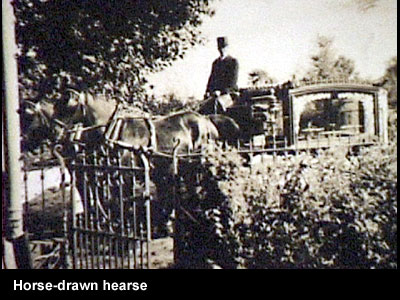

Throughout the ages Markethill and district has been home to a variety of rural pastimes and industries. These occupations have waxed and waned according to need but one has through necessity survived; the art of coffin making.
The design and creation of a coffin or casket requires significant amounts of skill and patience. Wood was purchased in sections and the top, bottom and sides of the coffin cut to measure. Small nicks were made along these sections approximately one-quarter inch from the top and the sides bent to accommodate the shoulders and arms of the body. Boiling water was poured over the wood during this to prevent the wood from splitting. The whole process was known as carfing.
A layer of fine straw was placed within the coffin underneath a waxed sheet or plastic cloth. Over this was affixed a white lining, sometimes of satin. The lining was held in place by small tacks the heads of which were covered in satin. To conceal the join a length of white braid was attached to the top of the coffin.
When the carpentry was completed the coffin was stained, polished and varnished. The top was attached using four brass screws to match the brass nameplate.
LOCAL COFFIN MAKERS
| William John Geddis | Eleven Lane Ends | 1880-1920 |
| Hugh Wallace | Markethill | 1901-1971 |
| Robert Gordon | Newry | 1924-1980 |
HUGH WALLACE
Hugh Wallace of Bryandrum, Markethill, was a coffin-maker for over half a century. He left Markethill Primary School to follow in his father's footsteps and for many years worked alongside his brother Robert. Together they made approximately two coffins each day for Robinson, Cummins and Morgan of Markethill. The wood used was oak, Spanish chestnut and deal. For each coffin completed Mr.Wallace received ten shillings.
According to Mr. Wallace, "It took three or four hours to make one, but there were no fancy handles and decoration like there are now...There were just plain Black Mountain ornaments around the sides".(Ulster Gazette article, early 1980's).
Mr.Wallace ceased to make coffins in the 1960's but continued to decorate the coffins until his retirement in 1971.
ROBERT GORDON
In 1924 Mr.Robert Gordon left the family farm at Jerrettspass to open a funeral undertaking business. He commenced in Antrim Town but in 1925 moved to Sugar Island in Newry. Expanding his business he finally settled at Erkine Street in Newry.
At that horses drew time funeral carriages. Mr.Gordon always purchased Irish horses, all black in colour, and trained them himself. Four horses were used to pull the carriage and Mr.Gordon remembered it as a sad day when the motorcar took over, "Funerals nowadays are not quite the same. There was something about the horses at a funeral that made a funeral cortege more impressive".
Mr.Gordon arranged the funeral of the Most Reverend Mulhern, Bishop of Dromore, in 1943 but undoubtedly the saddest occasion was the interment of six young RAF men drowned in Carlingford Lough on September 20th 1941.
On another occasion Mr.Gordon was approached by a man who wished to settle the account for his funeral expenses. The man died three months later. Mr.Gordon recalled this as the only time in his career that he was paid in advance.
Mr.Robert Gordon died in 1980 aged ninety-four. His two sons Thomas and Jim Gordon continued the family business.
REFERENCES
Information courtesy of the History Department, Markethill High School.






In the accompanying audio recording, Tommy Wallace talks about Bryandrum, his family, work (2mins 40s).

Use the audio controller to listen to this talk, given in 2013.